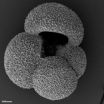(Press-News.org) The magnitude of climate change during Earth's deep past suggests that future temperatures may eventually rise far more than projected if society continues its pace of emitting greenhouse gases, a new analysis concludes.
The study, by National Center for Atmospheric Research (NCAR) scientist Jeffrey Kiehl, will appear as a "Perspectives" article in this week's issue of the journal Science.
The work was funded by the National Science Foundation (NSF), NCAR's sponsor.
Building on recent research, the study examines the relationship between global temperatures and high levels of carbon dioxide in the atmosphere tens of millions of years ago.
It warns that, if carbon dioxide emissions continue at their current rate through the end of this century, atmospheric concentrations of the greenhouse gas will reach levels that existed about 30 million to 100 million years ago.
Global temperatures then averaged about 29 degrees Fahrenheit (16 degrees Celsius) above pre-industrial levels.
Kiehl said that global temperatures may take centuries or millennia to fully adjust in response to the higher carbon dioxide levels.
Accorning to the study and based on recent computer model studies of geochemical processes, elevated levels of carbon dioxide may remain in the atmosphere for tens of thousands of years.
The study also indicates that the planet's climate system, over long periods of times, may be at least twice as sensitive to carbon dioxide as currently projected by computer models, which have generally focused on shorter-term warming trends.
This is largely because even sophisticated computer models have not yet been able to incorporate critical processes, such as the loss of ice sheets, that take place over centuries or millennia and amplify the initial warming effects of carbon dioxide.
"If we don't start seriously working toward a reduction of carbon emissions, we are putting our planet on a trajectory that the human species has never experienced," says Kiehl, a climate scientist who specializes in studying global climate in Earth's geologic past.
"We will have committed human civilization to living in a different world for multiple generations."
The Perspectives article pulls together several recent studies that look at various aspects of the climate system, while adding a mathematical approach by Kiehl to estimate average global temperatures in the distant past.
Its analysis of the climate system's response to elevated levels of carbon dioxide is supported by previous studies that Kiehl cites.
"This research shows that squaring the evidence of environmental change in the geologic record with mathematical models of future climate is crucial," says David Verardo, Director of NSF's Paleoclimate Program. "Perhaps Shakespeare's words that 'what's past is prologue' also apply to climate."
Kiehl focused on a fundamental question: when was the last time Earth's atmosphere contained as much carbon dioxide as it may by the end of this century?
If society continues its current pace of increasing the burning of fossil fuels, atmospheric levels of carbon dioxide are expected to reach about 900 to 1,000 parts per million by the end of this century.
That compares with current levels of about 390 parts per million, and pre-industrial levels of about 280 parts per million.
Since carbon dioxide is a greenhouse gas that traps heat in Earth's atmosphere, it is critical for regulating Earth's climate.
Without carbon dioxide, the planet would freeze over.
But as atmospheric levels of the gas rise, which has happened at times in the geologic past, global temperatures increase dramatically and additional greenhouse gases, such as water vapor and methane, enter the atmosphere through processes related to evaporation and thawing.
This leads to further heating.
Kiehl drew on recently published research that, by analyzing molecular structures in fossilized organic materials, showed that carbon dioxide levels likely reached 900 to 1,000 parts per million about 35 million years ago.
At that time, temperatures worldwide were substantially warmer than at present, especially in polar regions--even though the Sun's energy output was slightly weaker.
The high levels of carbon dioxide in the ancient atmosphere kept the tropics at about 9-18 F (5-10 C) above present-day temperatures.
The polar regions were some 27-36 F (15-20 C) above present-day temperatures.
Kiehl applied mathematical formulas to calculate that Earth's average annual temperature 30 to 40 million years ago was about 88 F (31 C)--substantially higher than the pre-industrial average temperature of about 59 F (15 C).
The study also found that carbon dioxide may have two times or more an effect on global temperatures than currently projected by computer models of global climate.
The world's leading computer models generally project that a doubling of carbon dioxide in the atmosphere would have a heating impact in the range of 0.5 to 1.0 degrees Celsius watts per square meter. (The unit is a measure of the sensitivity of Earth's climate to changes in greenhouse gases.)
However, the published data show that the comparable impact of carbon dioxide 35 million years ago amounted to about 2 C watts per square meter.
Computer models successfully capture the short-term effects of increasing carbon dioxide in the atmosphere.
But the record from Earth's geologic past also encompasses longer-term effects, which accounts for the discrepancy in findings.
The eventual melting of ice sheets, for example, leads to additional heating because exposed dark surfaces of land or water absorb more heat than ice sheets.
"This analysis shows that on longer time scales, our planet may be much more sensitive to greenhouse gases than we thought," Kiehl says.
Climate scientists are currently adding more sophisticated depictions of ice sheets and other factors to computer models.
As these improvements come on-line, Kiehl believes that the computer models and the paleoclimate record will be in closer agreement, showing that the impacts of carbon dioxide on climate over time will likely be far more substantial than recent research has indicated.
Because carbon dioxide is being pumped into the atmosphere at a rate that has never been experienced, Kiehl could not estimate how long it would take for the planet to fully heat up.
However, a rapid warm-up would make it especially difficult for societies and ecosystems to adapt, he says.
If emissions continue on their current trajectory, "the human species and global ecosystems will be placed in a climate state never before experienced in human history," the paper states.
INFORMATION:
Earth's hot past: Prologue to future climate?
Study of Earth's deep past leads to look into the future
2011-01-15
ELSE PRESS RELEASES FROM THIS DATE:
More intensive methods needed to identify TB in HIV-prone populations
2011-01-15
Identifying tuberculosis patients in Africa using passive methods is leaving many cases undiagnosed, according to researchers from the Netherlands, Kenya and the United States, who studied case detection methods in HIV-prone western Kenya. Tuberculosis (TB) occurs commonly in men and women with HIV, but in these patients TB can be more difficult to detect.
The findings were published online ahead of the print edition of the American Thoracic Society's American Journal of Respiratory and Critical Care Medicine.
"Limited information exists on the prevalence of tuberculosis ...
Mandatory menu labeling didn't change behavior at 1 fast food chain
2011-01-15
DURHAM, NC and KING COUNTY, WA – An effort in King County, Washington, to add nutrition facts labeling to fast food menus had no effect on consumer behavior in its first year.
As part of a comprehensive effort to stem the rise in obesity, the county, which includes Seattle and environs, imposed a mandatory menu labeling regulation on all restaurant chains with 15 or more locations beginning in January, 2009. Restaurants had to disclose calorie information at the point of purchase.
Researchers from Duke-National University of Singapore (NUS) Graduate Medical School ...
Speeding up E. coli detection
2011-01-15
A simple, automated method of tracking E. coli uses a laser to detect and monitor the microbe in potentially contaminated bodies of water or waterways. The technique described this month in the International Journal of Computational Biology and Drug Design could reduce the incidence of waterborne disease outbreaks.
Microbial contamination of water is a worldwide environmental and health problem. Water related diseases are the leading causes of illness and death in the world. The impacts of water quality on public health and economy are highly significant as evidenced ...
Warming climate means red deer rutting season arrives early
2011-01-15
Wild red deer on the Isle of Rum, which were featured in the BBC TV series Autumnwatch, are rutting earlier in the year, a study shows.
Scientists believe the annual rutting season on the Isle of Rum could be changing because of warming spring and summer temperatures. The study shows that the rutting and calving seasons are now up to two weeks earlier on average compared with 30 years ago.
The research was based on a 38-year study of the ecology of red deer on the Isle of Rum and used annual records of breeding success in more than 3,000 individually recognisable ...
Heavy metals and pesticides threaten a Huelva wetland
2011-01-15
The Estero de Domingo Rubio wetland, located near the Marismas del Odiel Natural Area in the Huelva estuary, is regionally, nationally and internationally protected thanks to its ecological value. However, its tributary rivers and the Ría de Huelva estuary pump manmade pollutants into it, which could affect its water quality and ecosystem.
Industrial activity, accumulations of dangerous waste, the expansion of farming, and excessive extraction of sand and gravel for the construction industry are the leading threats to the Estero de Domingo Rubio wetland, the tidal system ...
Tractors rolling over is top cause of agricultural deaths
2011-01-15
The people in Spain at greatest risk of suffering farming accidents are those aged over 65, followed by people under 16 and people from outside the agricultural sector. These are the results of a study by the Public University of Navarre (UPNA), which shows that most of these deaths are due to people being crushed by tractors.
"Aside from recognised farming workers, other employees die in this sector and these deaths are not recorded. Our objective was to compare the real and official data on fatal farming accidents and to classify the most commonly associated risks", ...
Bioactive compounds in berries can reduce high blood pressure
2011-01-15
Eating blueberries can guard against high blood pressure, according to new research by the University of East Anglia (UEA) and Harvard University.
High blood pressure – or hypertension – is one of the major cardiovascular diseases worldwide. It leads to stroke and heart disease and costs more than $300 billion each year. Around a quarter of
the adult population is affected globally – including 10 million people in the UK and one in three US adults.
Published next month in the American Journal of Clinical Nutrition, the new findings show that bioactive compounds in ...
Dramatic ocean circulation changes revealed
2011-01-15
The unusually cold weather this winter has been caused by a change in the winds.
Instead of the typical westerly winds warmed by Atlantic surface ocean currents, cold northerly Arctic winds are influencing much of Europe.
However, scientists have long suspected that far more severe and longer-lasting cold intervals have been caused by changes to the circulation of the warm Atlantic ocean currents themselves.
Now new research led by Cardiff University, with scientists in the UK and US, reveals that these ocean circulation changes may have been more dramatic than ...
Interactive window shopping
2011-01-15
A woman passing by the window display is captivated and asks her companion "Isn't the leather bag chic?" "Which one do you mean? There are so many of them." The woman points to one of the bags and as if by magic the luxurious purse appears on a display behind the shop window. Then she points to a button and the designer object rotates on the screen. "So that's what it looks like from the back." The woman passing by is impressed. She makes another gesture to zoom the bag towards her letting her to see every detail.
This particular shopping experience is courtesy of new ...
Measles virus plays role in Paget's disease of bone, Pitt-led team says
2011-01-15
PITTSBURGH, Jan. 14 – A gene from the measles virus plays a key role in the development of Paget's disease of bone, according to a team of researchers led by the University of Pittsburgh School of Medicine. Their findings, recently published in Cell Metabolism, confirm a long-held speculation that the childhood infection is an environmental trigger for the disease and reveal how the viral gene contributes to the development of its characteristic bone lesions.
"Our earlier work showed that bone cells called osteoclasts in about 70 percent of these patients contain a certain ...
LAST 30 PRESS RELEASES:
Scientists trace microplastics in fertilizer from fields to the beach
The Lancet Obstetrics, Gynecology, & Women’s Health: Taking paracetamol during pregnancy does not increase risk of autism, ADHD or intellectual disabilities, confirms new gold-standard evidence review
Taking paracetamol during pregnancy does not increase risk of autism, ADHD or intellectual disabilities
Harm reduction vending machines in New York State expand access to overdose treatment and drug test strips, UB studies confirm
University of Phoenix releases white paper on Credit for Prior Learning as a catalyst for internal mobility and retention
Canada losing track of salmon health as climate and industrial threats mount
Molecular sieve-confined Pt-FeOx catalysts achieve highly efficient reversible hydrogen cycle of methylcyclohexane-toluene
Investment in farm productivity tools key to reducing greenhouse gas
New review highlights electrochemical pathways to recover uranium from wastewater and seawater
Hidden pollutants in shale gas development raise environmental concerns, new review finds
Discarded cigarette butts transformed into high performance energy storage materials
Researchers highlight role of alternative RNA splicing in schizophrenia
NTU Singapore scientists find new way to disarm antibiotic-resistant bacteria and restore healing in chronic wounds
Research suggests nationwide racial bias in media reporting on gun violence
Revealing the cell’s nanocourier at work
Health impacts of nursing home staffing
Public views about opioid overdose and people with opioid use disorder
Age-related changes in sperm DNA may play a role in autism risk
Ambitious model fails to explain near-death experiences, experts say
Multifaceted effects of inward foreign direct investment on new venture creation
Exploring mutations that spontaneously switch on a key brain cell receptor
Two-step genome editing enables the creation of full-length humanized mouse models
Pusan National University researchers develop light-activated tissue adhesive patch for rapid, watertight neurosurgical sealing
Study finds so-called super agers tend to have at least two key genetic advantages
Brain stimulation device cleared for ADHD in the US is overall safe but ineffective
Scientists discover natural ‘brake’ that could stop harmful inflammation
Tougher solid electrolyte advances long-sought lithium metal batteries
Experts provide policy roadmap to reduce dementia risk
New 3D imaging system could address limitations of MRI, CT and ultrasound
First-in-human drug trial lowers high blood fats
[Press-News.org] Earth's hot past: Prologue to future climate?Study of Earth's deep past leads to look into the future




